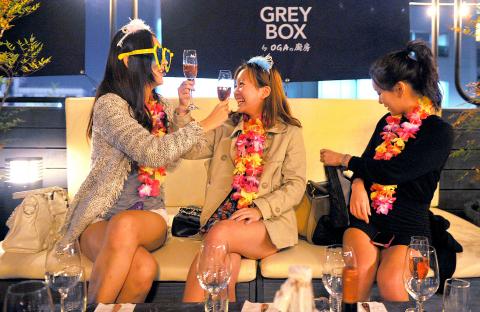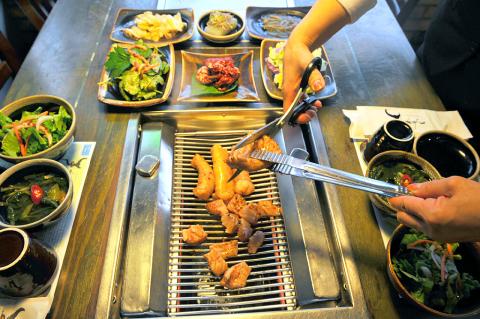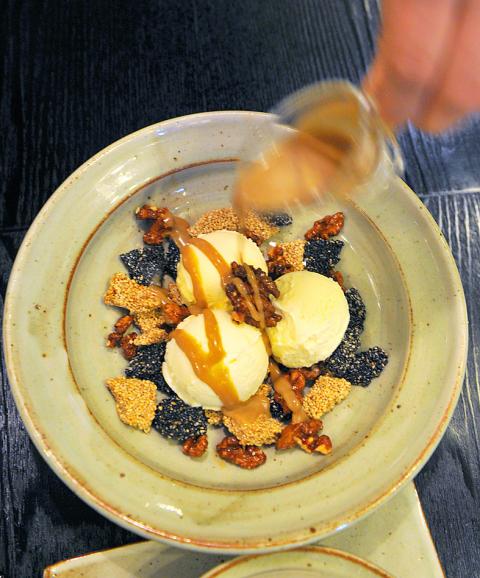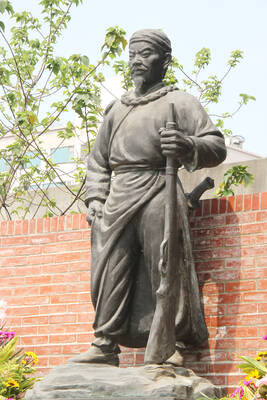Hundreds of millions have watched the dance and listened to the song — most without understanding a word — but very few have any idea what “Gangnam” is and what, if any, particular “style” it might have.
The Gangnam in the title of the global hit by South Korean rapper Psy is Seoul’s wealthiest residential and shopping district, lined with luxury boutiques, top-end bars, night clubs and restaurants frequented by celebrities.
But even among those Koreans who live or party regularly in Gangnam, which literally and unglamorously translates as “south of the river,” there is little consensus on what constitutes the district’s signature style.

Photo: AFP
Translating the song’s lyrics, which some see as satirizing the district’s self-importance and ostentatious wealth, offers little in the way of concrete insights.
Psy sings about being the “guy who downs boiling coffee in one shot” and who “goes completely crazy when the right time comes.”
Kwon Yu-Bi, a 23-year-old student and Gangnam nightlife regular, said the song was less about any particular place and more about a new-found hedonism in Asia’s fourth largest economy.

Photo: AFP
“Gangnam is just a symbolic place and I think the song really reflects Korea, where young people, including myself, enjoy a hectic and crazy night out,” Kwon told AFP.
A Gangnam residential address doesn’t come cheap, with the average apartment price — even with Seoul going through an extended real estate slump — set at around US$720,000.
One particular street, lined on both sides with outlets of global luxury brands such as Louis Vuitton, Gucci, Cartier and Prada has been compared to Rodeo Drive of Beverly Hills in California.

Photo: AFP
For Kim Hoo-Yeon, 23, the real Gangnam style is nothing more than an obsession with conspicuous consumption.
“Every time I go to Gangnam, I feel people come to show off how much money they have,” she said.
“I don’t even feel it’s worthwhile labeling it ‘Gangnam style,’” agreed 29-year-old Park Seong-Jun, who said the place was simply a magnet for anyone who could afford to go on a “crazy money-spending spree”.
The video that launched Psy and Gangnam Style to global fame and has notched up nearly 500 million views on YouTube certainly appears to poke fun at the district’s image of idle affluence.
It features the rapper breezing through a world of speed boats, yoga classes and exclusive clubs — all the while performing an eccentric horse-riding dance accompanied by beautiful models.
The implied emphasis on superficiality over substance is reinforced by the fact that the real Gangnam is well-known for celebrity-frequented plastic surgery clinics.
But Kim Soo-Mi, 49, who works as a pharmacist and has lived in Gangnam for 15 years, believes the image is a false one.
“It’s a pity that only the negative sides of Gangnam have been known through the song, since there’s so much more to the area than that,” said Kim, who sees her neighborhood as sophisticated rather than glamorous.
“When I visit other areas, that’s when I really feel Gangnam is a trendsetter — not just for fashion but for lifestyle in general,” she said.
And J.H. Lim, the owner of a high-end restaurant in the area, said Gangnam’s style was one of refined taste that appealed to a mature clientele.
“If someone’s looking for fast-paced fun and energy, there are other places in Seoul for that. Gangnam is more for high-profile adults, who want to enjoy the luxury and exclusivity”, the 55-year-old entrepreneur said.

JUNE 30 to JULY 6 After being routed by the Japanese in the bloody battle of Baguashan (八卦山), Hsu Hsiang (徐驤) and a handful of surviving Hakka fighters sped toward Tainan. There, he would meet with Liu Yung-fu (劉永福), leader of the Black Flag Army who had assumed control of the resisting Republic of Formosa after its president and vice-president fled to China. Hsu, who had been fighting non-stop for over two months from Taoyuan to Changhua, was reportedly injured and exhausted. As the story goes, Liu advised that Hsu take shelter in China to recover and regroup, but Hsu steadfastly

Taiwan’s politics is mystifying to many foreign observers. Gosh, that is strange, considering just how logical and straightforward it all is. Let us take a step back and review. Thanks to the Chinese Nationalist Party (KMT) and the Taiwan People’s Party (TPP), starting this year people will once again have Christmas Day off work. In 2002, the Scrooges in the Democratic Progressive Party (DPP) said “bah, humbug” to that. The holiday is not actually Christmas, but rather Constitution Day, celebrating the enactment of the Constitution of the Republic of China (ROC) on December 25, 1947. The DPP and the then pan-blue dominated legislature

Focus Taiwan reported last week that government figures showed unemployment in Taiwan is at historic lows: “The local unemployment rate fell 0.02 percentage points from a month earlier to 3.30 percent in May, the lowest level for the month in 25 years.” Historical lows in joblessness occurred earlier this year as well. The context? Labor shortages. The National Development Council (NDC) expects that Taiwan will be short 400,000 workers by 2030, now just five years away. The depth of the labor crisis is masked by the hundreds of thousands of migrant workers which the economy absolutely depends on, and the

If you’ve lately been feeling that the “Jurassic Park” franchise has jumped an even more ancient creature — the shark — hold off any thoughts of extinction. Judging from the latest entry, there’s still life in this old dino series. Jurassic World Rebirth captures the awe and majesty of the overgrown lizards that’s been lacking for so many of the movies, which became just an endless cat-and-mouse in the dark between scared humans against T-Rexes or raptors. Jurassic World Rebirth lets in the daylight. Credit goes to screenwriter David Koepp, who penned the original Jurassic Park, and director Gareth Edwards, who knows